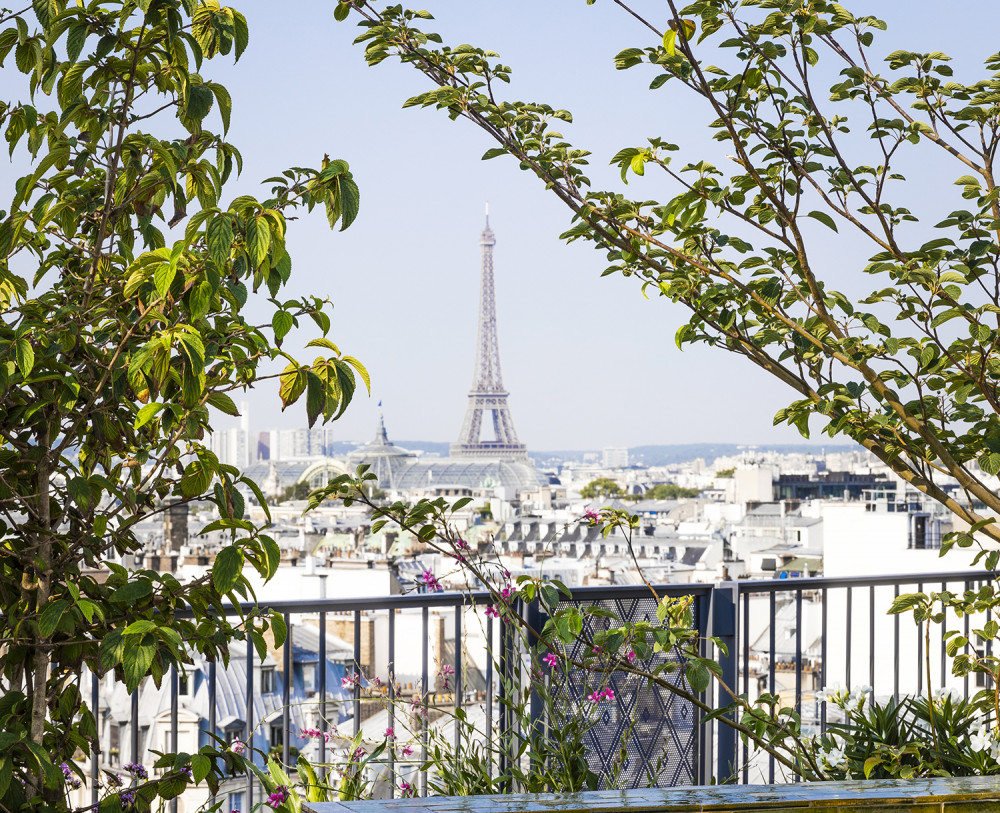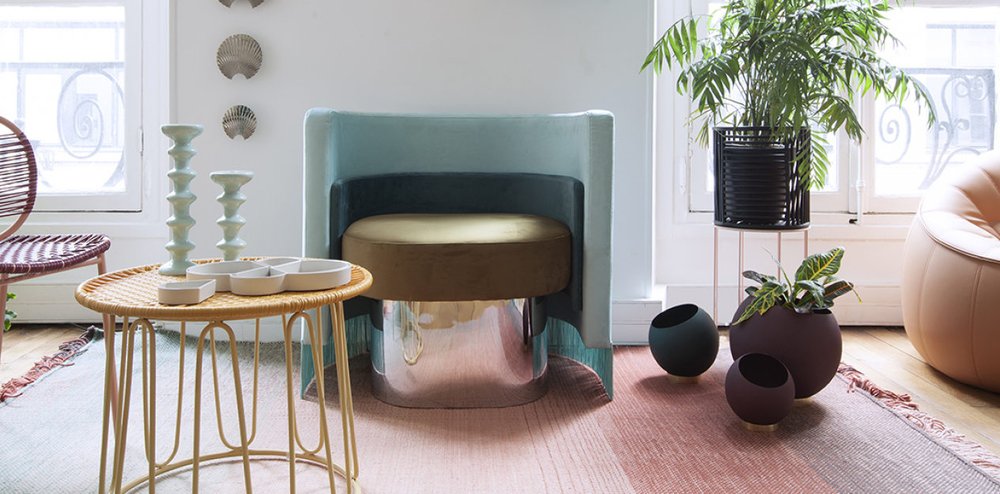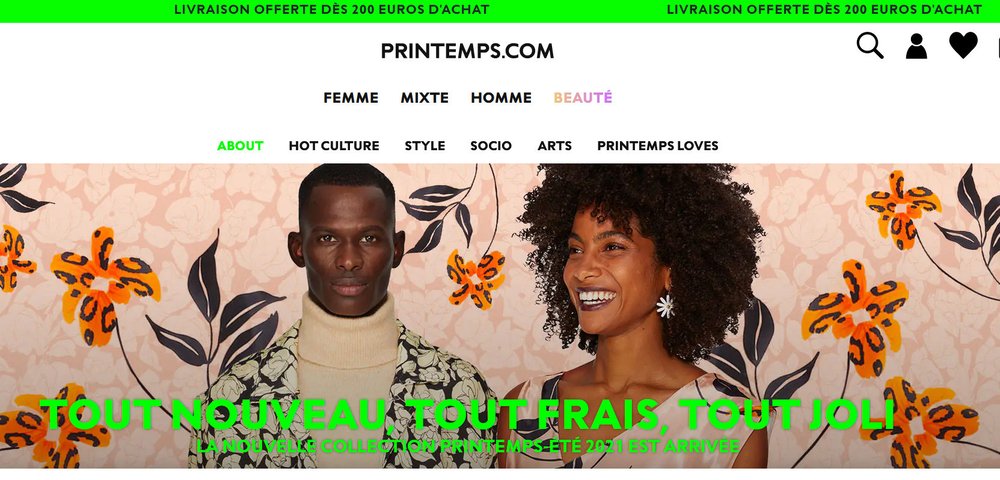On a cool early March morning, wintry sunlight is shining on the domed building
that is home to venerable Parisian department store Le Printemps Haussmann, designed in the 19th century by architect Paul Sédille. From his office, Jean-Marc Bellaiche can look down on the flagship of the department store group he took charge of last September.

Wearing a navy-blue suit, a white shirt with top button undone and high-end dark leather sneakers, the department store’s new president welcomed FashionNetwork.com, and presented his plans for the French retail distribution giant. A giant that, owing to the restrictions caused by the pandemic, is very much asleep at the moment.
“Resilience is part and parcel of Le Printemps’s history. But I would have preferred to start in my role without the November and February [store] closures,” said Bellaiche. “Right now, the equivalent of 85% of our revenue is not operational. We need to manage our day-to-day business and keep the company afloat despite these problems. But a large part of my time is devoted to planning the future. It’s a question of modernising, and of inventing the department store of the future,” he added.
According to Bellaiche, a luxury and retail specialist who has worked at consulting firm Boston Consulting Group, was a vice-president at jeweller Tiffany’s and, until last year, was in charge of partnerships and strategy at French unicorn Contentsquare, the future will not be 100% digital.
“I’m convinced people do love physical retail and department stores, even if they have embraced e-commerce. In December, and in January-February for the stores that were open, we recorded sales increases of over 50%, in some cases even doubling the previous years’ figures. This shows people are still keen on physical retail. Department stores, with their huge spaces, will continue to exist, but they need to transform themselves,” said Bellaiche.
To engineer this transformation, Bellaiche, a man in his fifties and a manager with an unflinching outlook, has ambitious plans. Overhauling Le Printemps means transforming a group founded in 1865 and owned since 2013 by Luxembourg-based company Disa - an investment fund pooling together several Qatari investors - a group that operates 19 department store branches, the Le Printemps website, eight Citadium stores and the Place des Tendances and Made in Design websites. In the 2018-19 financial year, the group recorded a revenue of €1.7 billion.

When Bellaiche joined the group, he assessed the situation and began to impose his own style. On day one, in typical start-up fashion, he set up a video-conference to which all employees were invited, something which has now become a ritual.
Start-up-style management techniques
Gradually, Bellaiche has also created a new cohort of close collaborators, bringing more women and younger faces into the group’s executive committee in recent weeks. Bellaiche likes the group’s sense of belonging and welcoming attitude, but he said he wants to evolve its work culture. “My goal is for every member of the Le Printemps staff, all 3,000 of them, and 10,000 if we include brand consultants, to feel like an entrepreneur. In order to put customers centre-stage again, sales assistants must be allowed to relay information to me freely,” he said.
Despite the new tone and open approach, there still remain several bones of contention within the group. Especially the thorny issue of the store closure plan announced at the end of last year, affecting seven branches and 428 jobs. At the end of February, the group’s employee representatives addressed an open letter to Bellaiche, stressing their bewilderment at the management’s failure to include all the group’s stores in the relaunch plan.
“I did reply to the unions. Of course, I am not keen on closing down stores. When I joined, I looked at each individual branch. We have managed to save some of them, but the four Le Printemps and three Citadium branches in question have structural issues that made relaunching them impossible. Although we have a solid financial base, we need to be able to self-finance, and to free up resources in order to be in a position to invest,” he said. The framework agreement signed at the start of 2021 should allow Le Printemps to deploy its transformation plan by the end of June.
According to the plan, the group’s remaining branches will reposition on the market within the next three to five years, with Le Printemps investing €40 million to €50 million annually. At the same time, store renovations will continue. Outside France, the group has put the planned Milan opening on hold, but has stepped up the pace for the one in Qatar. “The premises are located in the heart of Doha. We are locked and loaded to open in 2022, ahead of the football World Cup, with a 30,000 m2 space that will showcase our full assortment alongside some restaurants, all of it very high-tech. It will be a remarkable opening, consistent with our vision of the department store of the future,” said Bellaiche.
What are the linchpins of this vision? “The reinvention of Le Printemps will involve attracting new customers, offering a new definition of luxury, and a new Le Printemps brand platform,” said Bellaiche.
Recapturing the wow factor
On the clientèle side, Bellaiche is keen to reassess Le Printemps’s connection with tourists, especially those from China. “Chinese consumers are driving the luxury industry, with studies indicating they will soon account for 50% of the market,” he said. He wants to offer new services directly to these consumers, notably by forging new relationships with tour guides and international tour operators, a challenge that will be taken up by Emmanuel Suissa, the group’s new partnerships director. These initiatives are expected to hinge on the deployment of the Printemps.com site, currently active in France and the UK alone, as well as on a pop-up presence in key markets.

As for Le Printemps’s French clientèle, which has been instrumental in keeping the group resilient in these times of Covid, the goal is to appeal to younger consumers, tapping Citadium’s expertise. The group is also keen to strengthen its position in menswear, the leading category in some branches outside Paris, and attract more families. To make progress in this direction, Le Printemps has started to redefine the values that constitute its brand identity, working on themes like inclusivity - highlighted by the presence of models of all ages, origins and morphology on the group’s site - and sustainability.
The group has decided to go down the circular economy road, a direction that is consistent with the strategic evolution of the assortment commercialised by Le Printemps. Tourists are expected to be a scarce commodity in the coming seasons, but luxury goods will remain a feature at Le Printemps. “Previously, fashion, luxury and beauty products were the main elements. What is changing is the notion of luxury,” said Bellaiche. “We must anchor ourselves in tomorrow’s luxury, which is more inclusive, warmer and younger, and also less conventional. A new kind of luxury that is accessible at prices that are relevant to different consumer segments,” he added.
To attract these consumers, the group’s new management team is relying on exclusivity and a unique shopping experience, fundamentals the group is keen to focus on again. “We must recapture the wow factor. It’s in Le Printemps’s DNA. [The department store] was the first to install Vienna lifts at the end of the 19th century, the first to introduce electricity in-store, to distribute catalogues, to stage catwalk shows, and it even put a ski slope on the roof of the Haussmann [branch] in 1962. We must think ‘surprises’ again. This is why I’m planning to mix up the various departments’ approach,” said Bellaiche.

The boundaries between home decoration, food, beauty and apparel will therefore become more fluid. The Made in Design range will be deployed more extensively at Le Printemps branches in 2021. The new strategy will also enable sporting and high-tech goods to be featured. “We won’t be competing with Fnac and Decathlon, but we have the space to surprise customers with other product categories,” said Bellaiche. In December, Le Printemps successfully brought its gift selection to the ground floor, with products priced between €20 and €200.
Fashion and beauty will remain the mainstays however. Bellaiche did not specify how the product selection will evolve, but said that he wants “[Le Printemps] to assume again the role of talent scout for brands, one it has somewhat lost in the last few years. By opening up to a greater number of small brands ahead [of our competitors], we will manage to generate more traffic, and become even more attractive to our customers.” The group is notably aiming to forge links with leading European and American training academies.
The omni-channel challenge
Now that e-tail is booming, driven by the Covid-19 crisis, Le Printemps’s biggest battle will be fought on digital screens: “Our physical space is sumptuous, we must expand in the digital domain,” said Bellaiche. Printemps.com was launched twelve months ago, after many years of preparation, and is set to spearhead the group’s omni-channel drive.
A digitalisation effort that includes modernising the group’s IT and technology platforms and its supply chain, and which absorbs the majority of Le Printemps’s investment budget. It is a sizeable challenge. Printemps.com started with 200 luxury and designer labels, and now it showcases 400 of them, while the group’s physical stores feature 3,000 brands. “Our website must mirror the range in our physical stores,” said Bellaiche. It will then become a useful tool enabling shop assistants to boost the range they can offer to their customers, and generate additional sales.

“We are entering a world in which advice [to customers] will be a key plus. During lockdown, we have developed a new set of commercial muscles, remote selling. [The] Haussmann [branch] seems to be shut, but actually we have hundreds of people busy responding to their customers’ needs in France and around the world. And it works well,” said Bellaiche. Close-mouthed about the results, he nevertheless said the service is profitable.
Profitability is indeed a major challenge for Le Printemps. Last year, the group benefited from a state-backed loan and a “significant contribution” from its owner, but it must quickly get back on the profitability track.
“We’ve had a tough year,” admitted Bellaiche. “In the calendar year, the revenue is down by 40% and losses are huge. Across the entire financial year, which for us finishes at the end of March, we will have had 150 days of closures. Despite this, I think we managed to contain the crisis’ impact. Since we reopened, and then in December, we have put in a huge effort, and remote selling has grown. I must salute the energy and motivation of our employees in this difficult year,” he added.
Business is expected to recover gradually in the course of the current financial year, and the group is predicting at least another six months of lacklustre activity tourism-wise. And while deploying the group’s existing plans and closing down unprofitable branches, combined with the ongoing effort to slash costs, is set to improve Le Printemps’s results, a return to profitability is envisaged only from the 2022-23 financial year.
